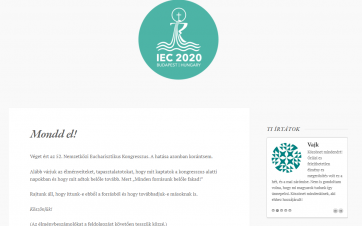
A Danube bank gem

In the Middle-Ages present territory of the Viziváros (literally Watertown) was the so-called St. Peter suburban area, named after the church built here in 1253 in honour of the martyr Peter. Land development started by order of King Béla IV, following the Mongol invasion of Hungary in 1242-44.
Devastation and restart
During the years of the Ottoman rule, and the subsequent liberation war severely damaged the Watertown district. St. Peter Church was completely destroyed, thus its faithful transformed the Maktul Mustafa mosque into a Christian worship place. After 1686 the depopulated district was revived upon the plans of the Royal Military Council. Germans were settled in the Castle Hill district, while Hungarians and Serbians began to populate the Watertown area. The Jesuits took the major role in organising the pastoral care.
Man plans….
Primate György Széchenyi restored the ancient parish in 1687, and entrusted the Jesuit order to perform the parish duties, who led it until the dissolution of their order in 1773. The Buda City Council purchased the restaurant “Horgonyhoz” from Mátyás Forstmayer in 1724 with the aim to set up a chapel in it, but very soon the former restaurant premise became way too small to host the services. The Council undertook to build a new church and parish for the Watertown community, however it was strongly delayed by the land purchase difficulties and the 1738 plague.
Church and school in one
Foundation stone laying ceremony of the new church took place on 26 July 1740 on the Feast of St. Anne. The first mass was presented six years later, on 26 July 1746, also on the Feast day of St. Anne. The following years were all about enlargement and embellishment. The second phase of the masonry was completed on 4 November 1762 upon the plans of master-bilder Kristóf Hamon. In addition to the 424 square metres church, a Hungarian school was founded by the Jesuits, one of its professors was Ferenc Faludi, poet and language reformer.
Earthquake, flood, siege
Less than one year passed after the building completion, when on 28 June 1763 an earthquake hit the territory, causing serious damages in the church. Due to the lengthy construction procedure and the restoration works, the church remained unconsecrated until 1805. On account of the frequent River Danube floods and the 1849 castle hill siege, the 19th century triggered further restoration works on the walls.
A special community
The Upper-Watertown parish community was founded in November 1918, with the first laity president, the later Prime Minister, Sándor Simonyi-Semadam. The community set up a procurement group aiming to provide cheap food supplies to the faithful, while the church revenues were used to support the poor and to protect children. Social care system was well characterized by the free medical care for the patients in need, not to mention the free legal aid.

Church swimming in light
St. Anne Church received a decorative floodlight as early as 1930. Artists for the Blessed Sacrament fresco in the oval-shaped dome were selected upon a tender in 1938, whereby Pál C. Molnár and Béla Kontuly were commissioned with the painting. Pál C. Molnár became known for his work exhibited in the Hungarian Pavilion of the Paris World Exhibition.
Salvation
World War II put the church building into danger again, when it suffered heavy damages during the 1945 Buda Castle siege. The parish premises were used for some time by the Germans as military command. In the ‘50s, due to excavation works of the nearby subway construction, the church was even threatened to be demolished. Fortunately the plan was abandoned, thanks to the action of the Monument Protection professionals. Moreover, the decision was grounded by the fact that Gábor Mócsai, having been appointed parish priest on 28 September 1977, restarted his predecessors’ activity in the field of pastoral and social ministry.
Mother Teresa’s visit
It was during Christmas of 1977 that a Holy Mass was held for the first time for blinds and partially sighted people. In 1982, Anna Fehér, special education teacher, established the St. Anne Home for visually impaired children in the church premises. Children of the home were visited by Mother Teresa and also by the wife of President Georg Bush. Later on the Home moved to the premises of the Batthyány László Roman Catholic Children’s Home, Kindergarten and Primary School for Blinds. Visually impaired adults still attend the Holy Mass here in the St. Anne Church.

An eye-catching church inside and outside
The Buda side landscape is unimaginable without this historical building. At the top of the main façade, between the twin-towers can be seen the eye of God, encircled by two angels. Below it takes place the coat of arms of Buda. The central figure of the façade, the monumental statue of St. Anne, Mother of Virgin Mary rises above us. The namesake figure of the church, placed in a statue booth on the façade, is the work of sculptor Antal Eberhardt, depicting St. Anne teaches the child Mary from a book. One of the most gilded buildings of Hungary hides an unusual octagonal centre space, above which an oval shaped dome overturns. In the sanctuary an 18th century Holy Trinity fresco, painted by Gergely Vogl, catches the sight of the visitors.
In the frame of the day of Parishes, on the 8th September, at 17:00 a Holy Mass in Latin and Romanian is going to be held in the St. Anne Church, with main celebrant S.E.R. Aurel Percă, Metropolitan Archbishop of Bucharest.
Source: esztergomi-ersekseg.hu, felsovizivaros.plebania.hu, Magyar Kurír
Photo: esztergomi-ersekseg.hu










